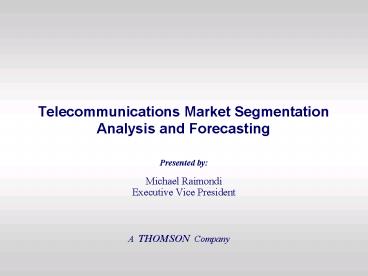Telecommunications Market Segmentation Analysis and Forecasting PowerPoint PPT Presentation
1 / 23
Title: Telecommunications Market Segmentation Analysis and Forecasting
1
Telecommunications Market SegmentationAnalysis
and Forecasting
- Presented by
- Michael Raimondi
- Executive Vice President
A THOMSON Company
2
Who is WEFA?
- The original economic forecasting firm started at
the request of business leaders who wanted
objective, independent forecasts for business
planning and analysis. - Founded in 1963 by Lawrence R. Klein, winner of
the 1980 Nobel Prize in Economics. - WEFA stays at the forefront of economic and
market analysis and forecasting. - WEFA uses its expertise to help clients
understand the effects of global, national, and
local economic conditions on their business by
product line and market segment.
3
Market Planning Applications
- Objective
- WEFA develops and provides detailed marketing
data and forecasts to support tactical and
strategic business decision-making for
telecommunications services businesses. - Marketing Focus
- By Line of Business -- Products and Services
- By Market Segment -- Business or Consumer Groups
- By Geographic Area -- Standard and Client Defined
Areas - By Business Location or Household
- Analyze Segment Size, Growth, and Future
Potential - Identify Opportunities and Risks and Target
Direct Marketing
4
Market Planning Needs
- How big is each market segment defined by
industry, by business size class, by consumer
group, by geographic location, and by product
usage? - What does this indicate about our market share
for each segment and geographic area? - What are the underlying growth prospects for each
segment? - How can I take advantage of the best market
opportunities, protect our vested-interest
segments, and avoid some of the risks in the
market? - What do the size and growth estimates imply about
the best sales prospects for our products?
5
WEFAs Analytical Process
- WEFAs Integrated Approach to
- Market Segment Analysis and Forecasting
- The Insight of Market Research.
- The Scope of Database Integration.
- The Precision of Quantitative Analysis.
- The Foresight of Econometric Forecasting.
6
A Solid Network of Models
7
Database Integration
- The Input-Output tables provide the initial
distribution across all 4-digit SIC code
industries. - The detailed data on employment by occupation and
information technology spending by industry
identify usage characteristics by industry by
service. - The government and association data provides
top-line benchmarks and state-level guidelines. - The statistical relationships and quantitative
methods lend consistency and rigor to the
intermediate and final results for all products,
industries, and states. - Allocations are made to all counties and ZIP
codes.
8
Numerous Data Sources
- Federal Communications Commission
- US Telephone Association
- Cellular Telecommunications Industry Association
- MultiMedia Telecommunications Association
- Survey of Communications Services
- Input-Output Tables of the US Economy
- Economic Census and County Business Patterns
- Current Population and Consumer Expenditure
Surveys - Industry-Occupation Matrix
- Clients Customer and Primary Data for Custom
Solutions
9
Segment Sizing
- The Business Market
- Employment
- Establishments
- Output
- Occupation Distributions
- By 4-digit SIC
- By State, MSA, County, and ZIP Code
- The Residential Market
- Population
- Households
- Income
- Occupation Distributions
- By Age/Income Cohort
- By State, MSA, County, and ZIP Code
10
Telecom Coverage
- Services
- Total Spending
- Local Service Spending
- Long Distance Service Spending
- Cellular Service Spending
- Toll Free Spending
- Data Communications
- Voice Communications
- ATM, Frame Relay, DSL, IP
- Products
- Access Lines
- Switched
- High Capacity
- Stations
- Telephone
- Other (e.g. modems, fax machines)
11
Voice vs. Data Transmission
Expected Revenue Growth in the U.S. (Compound
Annual Rates, 2000-2005)
12
Total Telecom Spending
Top/Bottom 5 States Based on Expected
Growth (Millions of Dollars, Compound Annual
Rates 2000-2005)
13
Total Telecom Spending
Top/Bottom 5 Industries Based on Expected
Growth (Millions of Dollars, Compound Annual
Rates 2000-2005)
14
Voice Telecom Spending
Top/Bottom 5 States Based on Expected
Growth (Millions of Dollars, Compound Annual
Rates 2000-2005)
15
Voice Telecom Spending
Top/Bottom 5 Industries Based on Expected
Growth (Millions of Dollars, Compound Annual
Rates 2000-2005)
16
Data Telecom Spending
Top/Bottom 5 States Based on Expected
Growth (Millions of Dollars, Compound Annual
Rates 2000-2005)
17
Data Telecom Spending
Top/Bottom 5 Industries Based on Expected
Growth (Millions of Dollars, Compound Annual
Rates 2000-2005)
18
Total Telecom Spending
Top/Bottom 5 Countries (Millions of Dollars,
Compound Annual Rates 2000-2005)
19
Voice Telecom Spending
Top/Bottom 5 Countries (Millions of Dollars,
Compound Annual Rates 2000-2005)
20
Data Telecom Spending
Top/Bottom 5 Countries (Millions of Dollars,
Compound Annual Rates 2000-2005)
21
Benefits
- More finely segment markets by industry, consumer
segment, geographic area, application, and
location. - More accurately measure penetration into each
segment on a total revenue or a revenue per
employee basis. - More carefully target key new markets, while
still protecting vested-interest business segment
and accounts. - More effectively allocate sales and marketing
resources. - More equitably set sales targets and measure
performance. - More precisely forecast sales nationally,
regionally, and locally by market segment.
22
Results
Watch Sales Grow
Detailed Market Segment Data and
Forecasts Better information Better decisions
Better allocations Better performance Even in
a fast-paced market, you can do better.
23
Boston ? Chicago ? Los AngelesNew York ?
Philadelphia ? Washington, DC Hong Kong ?
Frankfurt ? London ? Milan ? Paris Mexico City ?
Sao Paulo ? Pretoria ? Ottawa ? Toronto
A THOMSON Company

